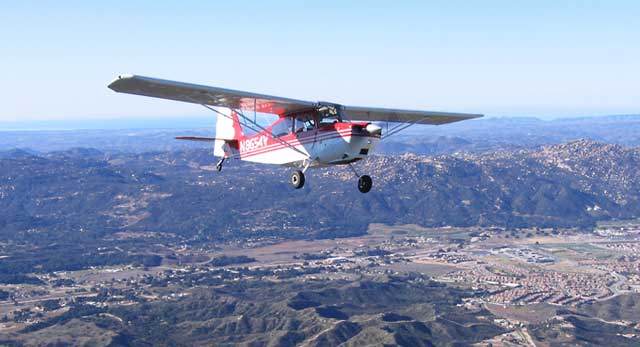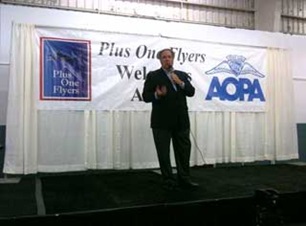
The Plus One fleet includes Beech Duchesses, Bonanzas, Cessna 152s, Cessna 172s, Cessna 182s, a Cessna 210, Piper Cherokees, a Piper Aztec, a Piper Malibu, two Cirrus SR22s, and three taildraggers, said club president Lawrence Massaro.
From its creation out of a board rift in 1985, Plus One Flyers Inc. has transformed itself into what it calls the premier flying club of Southern California. The club, based in San Diego, averages 1,050 members and operates 60-plus aircraft out of four airports.
Plus One Flyers is an extension of a former club, Flyers Inc., at the home base of Montgomery Field, said President Lawrence Massaro. “The `Plus One’ offshoot of that club was going to be the `elite/high end’ club with high-performance aircraft, but that endeavor could not get insurance,” he recalled. “When Flyers Inc. had a major rift on the board of directors, half of Flyers Inc.’s owners left and established Plus One Flyers as their new club.”
“The nature of our organization is a symbiotic one. The members and aircraft owners both share in the success of the organization,” said Massaro. “As flight hours are increased, owners benefit from more income. That allows them to keep prices low. Keeping prices affordable attracts more members which, in turn, attracts members, and the cycle continues.”
Eliminating a profit motive for daily business decisions keeps the focus on the needs of the membership and owners, not on some external need to make money, Massaro stated. “Financial security is an important component of our organization’s focus, but making a profit at the expense of reducing services or benefits to our membership is not a consideration.”
 Plus One Flyers hosts quarterly social events with guest speakers, including AOPA President Craig Fuller, who visited in 2011.
Plus One Flyers hosts quarterly social events with guest speakers, including AOPA President Craig Fuller, who visited in 2011.
Members pay a $99 initiation fee, while monthly dues are $31. “Rental rates are wet. We don’t have a social membership. It’s a one-size-fits-all structure,” said Massaro. “This levels the field and with a membership as large at Plus One Flyers, trying to have different levels of membership and keep track of the monthly billing for [them] would become a burden,” he said.
The Plus One fleet includes Beech Duchesses, Bonanzas, Cessna 152s, Cessna 172s, Cessna 182s, a Cessna 210, Piper Cherokees, a Piper Aztec, a Piper Malibu, two Cirrus SR22s, and three taildraggers, said Massaro.
The club has locations at McClellan-Palomar Field, Montgomery Field, Gillespie Field, and Ramona Field, and each is managed by an operations officer, said Massaro. “The officers are compensated for this duty, but at a nominal rate. Each of our operations officers are CFIs and typically are full time,” he explained.
Plus One Flyers hosts quarterly social events with guest speakers, including AOPA President Craig Fuller, who visited in April 2011, said Massaro. “We like to provide speakers that will motivate or educate the membership. Either way, in the end, the goal is to create an environment for learning and growing. We also encourage the members to bring family and friends that may be interested in flying to give them a small glimpse of what general aviation is about and open the door to becoming a pilot,” he said. “We have had a lot of success with the meetings in growing our membership and GA in Southern California.”
Plus One Flyers also happens to be one of the 11 pathfinder clubs chosen to help create the AOPA Flying Club Network. “The primary factor we see [as a pathfinder club] is the ability to share information, ideas, and concepts, between our organization and others to help the flying community. No two flying organizations are the same; each has their own philosophies, strategies, and goals,” said Massaro. “By bringing together groups of successful organizations and combining their corporate knowledge, AOPA may be able to disseminate that knowledge to new and existing clubs that may need assistance or guidance.”
For those considering forming a flying club, Massaro said the foundation for a successful enterprise is a business plan that is followed closely. “The application of sound business practices cannot be understated. In our organization, we have had to make many difficult decisions that may not have been the most popular among the membership,” he observed. “However, they were done to strengthen the long-term interests in maintaining the success of our organization. These types of decisions rarely ever seem to be very popular, but are necessary.”
Be prepared to make tough decisions, which lends itself to the need for strong leadership, said Massaro. “While volunteerism has its place, and we utilize it quite effectively, do not fall into the 100 percent volunteer ‘trap.’ Volunteerism is good in limited roles and can be a very effective method to help offset the costs in running an organization,” he said. “The trap is when critical functions are offloaded to volunteers. Human nature dictates that when something or a service is not being paid for, the level of enthusiasm may not be to the level expected or needed to successfully accomplish the duties or assignments required.”


